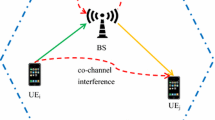Abstract
The severe interference in full-duplex (FD) cellular network largely degrade the system performance, especially for cell edge users. In this paper, hybrid full/half duplex cellular network which is composed of a mixture of FD and half duplex (HD) base-stations (BSs) is focused. In order to relieve the received inter-cell interference, frequency reuse (FR) is applied. The adopted FR schemes include traditional full FR and two kinds of fractional FR (FFR) named Strict FFR (StFFR) and Soft FFR (SoFFR). Stochastic geometry is adopted to evaluate the system performance. Tractable results of the ergodic rate and coverage probability for different FR schemes are obtained. Through the numerical results, we can observe that full FR and StFFR schemes can improve the user coverage probability at the expense of system spectrum efficiency (SE). SoFFR can improve both the coverage probability and the system SE. The numerical results also show that if the residual Self-interference is not very strong, operating all the BSs in FD mode can achieve the best performance, otherwise, it is better to operate all the BSs in HD mode.







Similar content being viewed by others
References
Sabharwal, A., Schniter, P., Guo, D., Bliss, D. W., Rangarajan, S., & Wichman, R. (2014). In-band full-duplex wireless: Challenges and opportunities. IEEE Journal on Selected Areas in Communications, 32(9), 1637–1652.
Kim, D., Lee, H., & Hong, D. (2015). A survey of in-band full-duplex transmission: From the perspective of PHY and MAC layers. IEEE Communications Surveys & Tutorials, 17(4), 2017–2046.
Bharadia, D., McMilin, E., & Katti, S. (2013). Full duplex radios. ACM SIGCOMM Computer Communication Review, 43(4), 375–386.
Choi, J. I., Jain, M., Srinivasan, K., Levis, P., & Katti, S. (2010). Achieving single channel, full duplex wireless communication. In Proceedings of the sixteenth annual international conference on Mobile computing and networking (MobiCom ’10). ACM, New York, NY, USA, pp. 1–12.
Liao, Y., Song, L., Han, Z., & Li, Y. (2015). Full duplex cognitive radio: A new design paradigm for enhancing spectrum usage. IEEE Communications Magazine, 53(5), 138–145.
Liu, G., Yu, F. R., Ji, H., Leung, V. C., & Li, X. (2015). In-band full-duplex relaying: A survey, research issues and challenges. IEEE Communications Surveys & Tutorials, 17(2), 500–524.
Riihonen, T., Werner, S., & Wichman, R. (2011). Hybrid full-duplex/half-duplex relaying with transmit power adaptation. IEEE Transactions on Wireless Communications, 10(9), 3074–3085.
Ahmed, E., Eltawil, A. M., & Sabharwal, A. (2013). Rate gain region and design tradeoffs for full-duplex wireless communications. IEEE Transactions on Wireless Communications, 12(7), 3556–3565.
Chai, X., Liu, T., Xing, C., Xiao, H., & Zhang, Z. (2016). Throughput improvement in cellular networks via full-duplex based device-to-device communications. IEEE Access, 4, 7645–7657.
Bai, J., & Sabharwal, A. (2013). Distributed full-duplex via wireless side-channels: Bounds and protocols. IEEE Transactions on Wireless Communications, 12(8), 4162–4173.
Nguyen, D., Tran, L. N., Pirinen, P., & Latva-aho, M. (2013). Precoding for full duplex multiuser MIMO systems: Spectral and energy efficiency maximization. IEEE Transactions on Signal Processing, 61(16), 4038–4050.
Nguyen, D., Tran, L. N., Pirinen, P., & Latva-aho, M. (2014). On the spectral efficiency of full-duplex small cell wireless systems. IEEE Transactions on wireless communications, 13(9), 4896–4910.
AlAmmouri, A., ElSawy, H., Amin, O., & Alouini, M. S. (2016). In-band \(alpha\)-duplex scheme for cellular networks: A stochastic geometry approach. IEEE Transactions on Wireless Communications, 15(10), 6797–6812.
Goyal, S., Liu, P., Hua, S., & Panwar, S. (2013). Analyzing a full-duplex cellular system. In IEEE 2013 47th annual conference on in information sciences and systems (CISS), IEEE, Baltimore, MD, pp. 1-6.
Thomsen, H., Popovski, P., De Carvalho, E., Pratas, N. K., Kim, D. M., & Boccardi, F. (2016). Compflex: Comp for in-band wireless full duplex. IEEE Wireless Communications Letters, 5(2), 144–147.
Simeone, O., Erkip, E., & Shamai, S. (2014). Full-duplex cloud radio access networks: An information-theoretic viewpoint. IEEE Wireless Communications Letters, 3(4), 413–416.
Lee, J., & Quek, T. Q. (2015). Hybrid full-/half-duplex system analysis in heterogeneous wireless networks. IEEE Transactions on Wireless Communications, 14(5), 2883–2895.
Goyal, S., Liu, P., & Panwar, S. S. (2016). User selection and power allocation in full duplex multi-cell networks. IEEE Transactions on Vehicular Technology (in press).
Goyal, S., Galiotto, C., Marchetti, N., & Panwar, S. (2016). Throughput and coverage for a mixed full and half duplex small cell network. In 2016 IEEE international conference on communications (ICC), IEEE, Kuala Lumpur, pp. 1–7.
Himayat, N., Talwar, S., Rao, A., & Soni, R. (2010). Interference management for 4G cellular standards [WIMAX/LTE UPDATE]. IEEE Communications Magazine, 48(8), 86–92.
Boudreau, G., Panicker, J., Guo, N., Chang, R., Wang, N., & Vrzic, S. (2009). Interference coordination and cancellation for 4G networks. IEEE Communications Magazine, 47(4), 74–81.
Andrews, J. G., Baccelli, F., & Ganti, R. K. (2011). A tractable approach to coverage and rate in cellular networks. IEEE Transactions on Communications, 59(11), 3122–3134.
Novlan, T. D., Dhillon, H. S., & Andrews, J. G. (2013). Analytical modeling of uplink cellular networks. IEEE Transactions on Wireless Communications, 12(6), 2669–2679.
Jeffrey, A., & Zwillinger, D. (Eds.). (2007). Table of integrals, series, and products. San Diego: Academic Press.
Access, E. U. T. R. (2010). Further advancements for E-UTRA physical layer aspects. 3GPP TR 36.814, Tech. Rep.
Acknowledgements
This work was supported by National Basic Research Program of China (2012CB316002), National Natural Science Foundation of China (61631013), China’s 863 Project (2015AA01A706), Science Fund for Creative Research Groups of NSFC (61321061), Tsinghua University Initiative Scientific Research Program (2015Z02-3), National S&T Major Project (2014ZX03001011), Key project of international science and technology innovation cooperation between the government(2016YFE0122900), Huawei Technologies.
Author information
Authors and Affiliations
Corresponding author
Rights and permissions
About this article
Cite this article
Bi, W., Su, X., Xiao, L. et al. Performance Analysis of Hybrid Duplex Cellular System Using Frequency Reuse. Wireless Pers Commun 96, 3553–3568 (2017). https://doi.org/10.1007/s11277-017-4280-6
Published:
Issue Date:
DOI: https://doi.org/10.1007/s11277-017-4280-6




